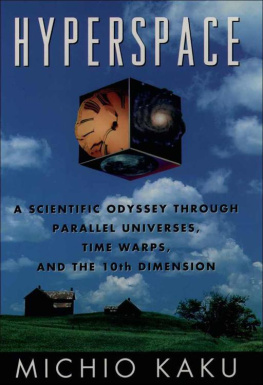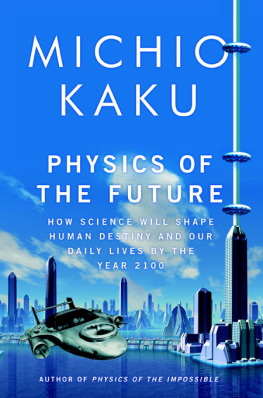
CONTENTS
To my loving wife, Shizue,
and to
Michelle and Alyson
PREFACE
If at first an idea does not sound absurd, then there is no hope for it.
ALBERT EINSTEIN
One day, would it be possible to walk through walls? To build starships that can travel faster than the speed of light? To read other peoples minds? To become invisible? To move objects with the power of our minds? To transport our bodies instantly through outer space?
Since I was a child, Ive always been fascinated by these questions. Like many physicists, when I was growing up, I was mesmerized by the possibility of time travel, ray guns, force fields, parallel universes, and the like. Magic, fantasy, science fiction were all a gigantic playground for my imagination. They began my lifelong love affair with the impossible.
I remember watching the old Flash Gordon reruns on TV. Every Saturday, I was glued to the TV set, marveling at the adventures of Flash, Dr. Zarkov, and Dale Arden and their dazzling array of futuristic technology: the rocket ships, invisibility shields, ray guns, and cities in the sky. I never missed a week. The program opened up an entirely new world for me. I was thrilled by the thought of one day rocketing to an alien planet and exploring its strange terrain. Being pulled into the orbit of these fantastic inventions I knew that my own destiny was somehow wrapped up with the marvels of the science that the show promised.
As it turns out, I was not alone. Many highly accomplished scientists originally became interested in science through exposure to science fiction. The great astronomer Edwin Hubble was fascinated by the works of Jules Verne. As a result of reading Vernes work, Hubble abandoned a promising career in law, and, disobeying his fathers wishes, set off on a career in science. He eventually became the greatest astronomer of the twentieth century. Carl Sagan, noted astronomer and bestselling author, found his imagination set afire by reading Edgar Rice Burroughss John Carter of Mars novels. Like John Carter, he dreamed of one day exploring the sands of Mars.
I was just a child the day when Albert Einstein died, but I remember people talking about his life, and death, in hushed tones. The next day I saw in the newspapers a picture of his desk, with the unfinished manuscript of his greatest, unfinished work. I asked myself, What could be so important that the greatest scientist of our time could not finish it? The article claimed that Einstein had an impossible dream, a problem so difficult that it was not possible for a mortal to finish it. It took me years to find out what that manuscript was about: a grand, unifying theory of everything. His dreamwhich consumed the last three decades of his lifehelped me to focus my own imagination. I wanted, in some small way, to be part of the effort to complete Einsteins work, to unify the laws of physics into a single theory.
As I grew older I began to realize that although Flash Gordon was the hero and always got the girl, it was the scientist who actually made the TV series work. Without Dr. Zarkov, there would be no rocket ship, no trips to Mongo, no saving Earth. Heroics aside, without science there is no science fiction.
I came to realize that these tales were simply impossible in terms of the science involved, just flights of the imagination. Growing up meant putting away such fantasy. In real life, I was told, one had to abandon the impossible and embrace the practical.
However, I concluded that if I was to continue my fascination with the impossible, the key was through the realm of physics. Without a solid background in advanced physics, I would be forever speculating about futuristic technologies without understanding whether or not they were possible. I realized I needed to immerse myself in advanced mathematics and learn theoretical physics. So that is what I did.
In high school for my science fair project I assembled an atom smasher in my moms garage. I went to the Westinghouse company and gathered 400 pounds of scrap transformer steel. Over Christmas I wound 22 miles of copper wire on the high school football field. Eventually I built a 2.3-million-electron-volt betatron particle accelerator, which consumed 6 kilowatts of power (the entire output of my house) and generated a magnetic field of 20,000 times the Earths magnetic field. The goal was to generate a beam of gamma rays powerful enough to create antimatter.
My science fair project took me to the National Science Fair and eventually fulfilled my dream, winning a scholarship to Harvard, where I could finally pursue my goal of becoming a theoretical physicist and follow in the footsteps of my role model, Albert Einstein.
Today I receive e-mails from science fiction writers and screenwriters asking me to help them sharpen their own tales by exploring the limits of the laws of physics.
T HE I MPOSSIBLE I S R ELATIVE
As a physicist, I have learned that the impossible is often a relative term. Growing up, I remember my teacher one day walking up to the map of the Earth on the wall and pointing out the coastlines of South America and Africa. Wasnt it an odd coincidence, she said, that the two coastlines fit together, almost like a jigsaw puzzle? Some scientists, she said, speculated that perhaps they were once part of the same, vast continent. But that was silly. No force could possibly push two gigantic continents apart. Such thinking was impossible, she concluded.
Later that year we studied the dinosaurs. Wasnt it strange, our teacher told us, that the dinosaurs dominated the Earth for millions of years, and then one day they all vanished? No one knew why they had all died off. Some paleontologists thought that maybe a meteor from space had killed them, but that was impossible, more in the realm of science fiction.
Today we now know that through plate tectonics the continents do move, and that 65 million years ago a gigantic meteor measuring six miles across most likely did obliterate the dinosaurs and much of life on Earth. In my own short lifetime I have seen the seemingly impossible become established scientific fact over and over again. So is it impossible to think we might one day be able to teleport ourselves from one place to another, or build a spaceship that will one day take us light-years away to the stars?
Normally such feats would be considered impossible by todays physicists. Might they become possible within a few centuries? Or in ten thousand years, when our technology is more advanced? Or in a million years? To put it another way, if we were to somehow encounter a civilization a million years more advanced than ours, would their everyday technology appear to be magic to us? That, at its heart, is one of the central questions running through this book; just because something is impossible today, will it remain impossible centuries or millions of years into the future?
Given the remarkable advances in science in the past century, especially the creation of the quantum theory and general relativity, it is now possible to give rough estimates of when, if ever, some of these fantastic technologies may be realized. With the coming of even more advanced theories, such as string theory, even concepts bordering on science fiction, such as time travel and parallel universes, are now being re-evaluated by physicists. Think back 150 years to those technological advances that were declared impossible by scientists at the time and that have now become part of our everyday lives. Jules Verne wrote a novel in 1863, Paris in the Twentieth Century, which was locked away and forgotten for over a century until it was accidentally discovered by his great-grandson and published for the first time in 1994. In it Verne predicted what Paris might look like in the year 1960. His novel was filled with technology that was clearly considered impossible in the nineteenth century, including fax machines, a world-wide communications network, glass skyscrapers, gas-powered automobiles, and high-speed elevated trains.
Next page












